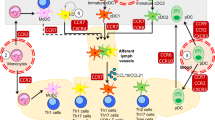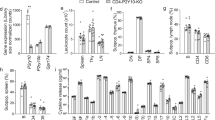Abstract
Chemokines have long been known to orchestrate dendritic-cell migration in the body. However, recent evidence has shown that chemokines not only direct the trafficking of dendritic cells but also can regulate their maturation status. Here, we propose that this dual function of chemokines ensures that T cells and dendritic cells meet in T-cell regions of lymphoid organs and that antigen is presented in an immunologically optimal context for T-cell priming.
This is a preview of subscription content, access via your institution
Access options
Subscribe to this journal
Receive 12 print issues and online access
$209.00 per year
only $17.42 per issue
Buy this article
- Purchase on Springer Link
- Instant access to full article PDF
Prices may be subject to local taxes which are calculated during checkout


Similar content being viewed by others
References
Ansel, K. M., McHeyzer-Williams, L. J., Ngo, V. N., McHeyzer-Williams, M. G. & Cyster, J. G. In vivo-activated CD4 T cells upregulate CXC chemokine receptor 5 and reprogram their response to lymphoid chemokines. J. Exp. Med. 190, 1123?1134 (1999).
Bonecchi, R. et al. Differential expression of chemokine receptors and chemotactic responsiveness of type 1 T helper cells (TH1s) and TH2s. J. Exp. Med. 187, 129?134 (1998).
Sallusto, F. et al. Switch in chemokine receptor expression upon TCR stimulation reveals novel homing potential for recently activated T cells. Eur. J. Immunol. 29, 2037?2045 (1999).
Sallusto, F. et al. Rapid and coordinated switch in chemokine receptor expression during dendritic cell maturation. Eur. J. Immunol. 28, 2760?2769 (1998).
Banchereau, J. & Steinman, R. M. Dendritic cells and the control of immunity. Nature 392, 245?252 (1998).
Pulendran, B., Palucka, K. & Banchereau, J. Sensing pathogens and tuning immune responses. Science 293, 253?256 (2001).
Geijtenbeek, T. B., van Vliet, S. J., Engering, A., 't Hart, B. A. & van Kooyk, Y. Self- and nonself-recognition by C-type lectins on dendritic cells. Annu. Rev. Immunol. 22, 33?54 (2004).
Inohara, N. & Nunez, G. NODs: intracellular proteins involved in inflammation and apoptosis. Nature Rev. Immunol. 3, 371?382 (2003).
Rogers, N. C. et al. Syk-dependent cytokine induction by Dectin-1 reveals a novel pattern recognition pathway for C type lectins. Immunity 22, 507?517 (2005).
Sozzani, S. et al. Differential regulation of chemokine receptors during dendritic cell maturation: a model for their trafficking properties. J. Immunol. 161, 1083?1086 (1998).
Yanagihara, S., Komura, E., Nagafune, J., Watarai, H. & Yamaguchi, Y. EBI1/CCR7 is a new member of dendritic cell chemokine receptor that is upregulated upon maturation. J. Immunol. 161, 3096?3102 (1998).
Dieu, M. C. et al. Selective recruitment of immature and mature dendritic cells by distinct chemokines expressed in different anatomic sites. J. Exp. Med. 188, 373?386 (1998).
Forster, R. et al. CCR7 coordinates the primary immune response by establishing functional microenvironments in secondary lymphoid organs. Cell 99, 23?33 (1999).
Gunn, M. D. et al. A chemokine expressed in lymphoid high endothelial venules promotes the adhesion and chemotaxis of naive T lymphocytes. Proc. Natl Acad. Sci. USA 95, 258?263 (1998).
Yoshida, R. et al. Molecular cloning of a novel human CC chemokine EBI1-ligand chemokine that is a specific functional ligand for EBI1, CCR7. J. Biol. Chem. 272, 13803?13809 (1997).
Gunn, M. D. et al. Mice lacking expression of secondary lymphoid organ chemokine have defects in lymphocyte homing and dendritic cell localization. J. Exp. Med. 189, 451?460 (1999).
Luther, S. A., Tang, H. L., Hyman, P. L., Farr, A. G. & Cyster, J. G. Co-expression of the chemokines ELC and SLC by T zone stromal cells and deletion of the ELC gene in the plt/plt mouse. Proc. Natl Acad. Sci. USA 97, 12694?12699 (2000).
Marsland, B. J. et al. CCL19 and CCL21 induce a potent proinflammatory differentiation program in licensed dendritic cells. Immunity 22, 493?505 (2005).
Junt, T. et al. Antiviral immune responses in the absence of organized lymphoid T cell zones in plt/plt mice. J. Immunol. 168, 6032?6040 (2002).
Ueno, T. et al. CCR7 signals are essential for cortex-medulla migration of developing thymocytes. J. Exp. Med. 200, 493?505 (2004).
Junt, T. et al. Impact of CCR7 on priming and distribution of antiviral effector and memory CTL. J. Immunol. 173, 6684?6693 (2004).
Yanagawa, Y. & Onoe, K. CCR7 ligands induce rapid endocytosis in mature dendritic cells with concomitant upregulation of Cdc42 and Rac activities. Blood 101, 4923?4929 (2003).
Yanagawa, Y. & Onoe, K. CCL19 induces rapid dendritic extension of murine dendritic cells. Blood 100, 1948?1956 (2002).
Sanchez-Sanchez, N. et al. Chemokine receptor CCR7 induces intracellular signalling that inhibits apoptosis of mature dendritic cells. Blood 104, 619?625 (2004).
Lee, Y., Eo, S. K., Rouse, R. J. & Rouse, B. T. Influence of CCR7 ligand DNA preexposure on the magnitude and duration of immunity. Virology 312, 169?180 (2003).
Hillinger, S. et al. EBV-induced molecule 1 ligand chemokine (ELC/CCL19) promotes IFN-γ-dependent antitumour responses in a lung cancer model. J. Immunol. 171, 6457?6465 (2003).
Trifilo, M. J. & Lane, T. E. The CC chemokine ligand 3 regulates CD11c+CD11b+CD8α− dendritic cell maturation and activation following viral infection of the central nervous system: implications for a role in T cell activation. Virology 327, 8?15 (2004).
Gu, L. et al. Control of TH2 polarization by the chemokine monocyte chemoattractant protein-1. Nature 404, 407?411 (2000).
Braun, M. C., Lahey, E. & Kelsall, B. L. Selective suppression of IL-12 production by chemoattractants. J. Immunol. 164, 3009?3017 (2000).
Blease, K. et al. Enhanced pulmonary allergic responses to Aspergillus in CCR2−/− mice. J. Immunol. 165, 2603?2611 (2000).
Traynor, T. R., Kuziel, W. A., Toews, G. B. & Huffnagle, G. B. CCR2 expression determines T1 versus T2 polarization during pulmonary Cryptococcus neoformans infection. J. Immunol. 164, 2021?2027 (2000).
Molon, B. et al. T cell co-stimulation by chemokine receptors. Nature Immunol. 6, 465?471 (2005).
Karpus, W. J. et al. Differential CC chemokine-induced enhancement of T helper cell cytokine production. J. Immunol. 158, 4129?4136 (1997).
Haegel-Kronenberger, H. et al. Adhesive and/or signalling functions of CD44 isoforms in human dendritic cells. J. Immunol. 161, 3902?3911 (1998).
la Sala, A. et al. Extracellular ATP induces a distorted maturation of dendritic cells and inhibits their capacity to initiate TH1 responses. J. Immunol. 166, 1611?1617 (2001).
Brand, U. et al. Influence of extracellular matrix proteins on the development of cultured human dendritic cells. Eur. J. Immunol. 28, 1673?1680 (1998).
Scandella, E. et al. CCL19/CCL21-triggered signal transduction and migration of dendritic cells requires prostaglandin E2. Blood 103, 1595?1601 (2004).
Partida-Sanchez, S. et al. Regulation of dendritic cell trafficking by the ADP-ribosyl cyclase CD38: impact on the development of humoral immunity. Immunity 20, 279?291 (2004).
Sporri, R. & Reis e Sousa, C. Inflammatory mediators are insufficient for full dendritic cell activation and promote expansion of CD4+ T cell populations lacking helper function. Nature Immunol. 6, 163?170 (2005).
Ruedl, C., Kopf, M. & Bachmann, M. F. CD8+ T cells mediate CD40-independent maturation of dendritic cells in vivo. J. Exp. Med. 189, 1875?1884 (1999).
Mintern, J. D., Davey, G. M., Belz, G. T., Carbone, F. R. & Heath, W. R. Cutting edge: precursor frequency affects the helper dependence of cytotoxic T cells. J. Immunol. 168, 977?980 (2002).
Fujii, S., Liu, K., Smith, C., Bonito, A. J. & Steinman, R. M. The linkage of innate to adaptive immunity via maturing dendritic cells in vivo requires CD40 ligation in addition to antigen presentation and CD80/86 co-stimulation. J. Exp. Med. 199, 1607?1618 (2004).
Alexander, J. & Hunter, C. A. Immunoregulation during toxoplasmosis. Chem. Immunol. 70, 81?102 (1998).
Aliberti, J. et al. CCR5 provides a signal for microbial induced production of IL-12 by CD8α+ dendritic cells. Nature Immunol. 1, 83?87 (2000).
Aliberti, J. et al. Molecular mimicry of a CCR5 binding-domain in the microbial activation of dendritic cells. Nature Immunol. 4, 485?490 (2003).
Billich, A., Winkler, G., Aschauer, H., Rot, A. & Peichl, P. Presence of cyclophilin A in synovial fluids of patients with rheumatoid arthritis. J. Exp. Med. 185, 975?980 (1997).
Sherry, B., Yarlett, N., Strupp, A. & Cerami, A. Identification of cyclophilin as a proinflammatory secretory product of lipopolysaccharide-activated macrophages. Proc. Natl Acad. Sci. USA 89, 3511?3515 (1992).
Xu, Q., Leiva, M. C., Fischkoff, S. A., Handschumacher, R. E. & Lyttle, C. R. Leukocyte chemotactic activity of cyclophilin. J. Biol. Chem. 267, 11968?11971 (1992).
Lin, C. L. et al. Macrophage-tropic HIV induces and exploits dendritic cell chemotaxis. J. Exp. Med. 192, 587?594 (2000).
Weissman, D., Li, Y., Orenstein, J. M. & Fauci, A. S. Both a precursor and a mature population of dendritic cells can bind HIV. However, only the mature population that expresses CD80 can pass infection to unstimulated CD4+ T cells. J. Immunol. 155, 4111?4117 (1995).
Granelli-Piperno, A., Golebiowska, A., Trumpfheller, C., Siegal, F. P. & Steinman, R. M. HIV-1-infected monocyte-derived dendritic cells do not undergo maturation but can elicit IL-10 production and T cell regulation. Proc. Natl Acad. Sci. USA 101, 7669?7674 (2004).
Majumder, B. et al. Human immunodeficiency virus type 1 Vpr impairs dendritic cell maturation and T-cell activation: implications for viral immune escape. J. Virol. 79, 7990?8003 (2005).
Acknowledgements
We would like to thank N. Harris and G. Jennings for carefully reading the manuscript and R. Steinman for helpful discussion.
Author information
Authors and Affiliations
Corresponding author
Ethics declarations
Competing interests
The authors declare no competing financial interests.
Related links
Rights and permissions
About this article
Cite this article
Bachmann, M., Kopf, M. & Marsland, B. Chemokines: more than just road signs. Nat Rev Immunol 6, 159–164 (2006). https://doi.org/10.1038/nri1776
Issue Date:
DOI: https://doi.org/10.1038/nri1776
This article is cited by
-
Blood–brain barrier: emerging trends on transport models and new-age strategies for therapeutics intervention against neurological disorders
Molecular Brain (2022)
-
GPR182 limits antitumor immunity via chemokine scavenging in mouse melanoma models
Nature Communications (2022)
-
Chemokines and matrix metalloproteinases in cerebrospinal fluid of patients with central nervous system complications caused by varicella-zoster virus
Journal of Neuroinflammation (2019)
-
CCR2 and CCR5 promote diclofenac-induced hepatotoxicity in mice
Naunyn-Schmiedeberg's Archives of Pharmacology (2019)
-
Secreted Ectodomain of SIGLEC-9 and MCP-1 Synergistically Improve Acute Liver Failure in Rats by Altering Macrophage Polarity
Scientific Reports (2017)



